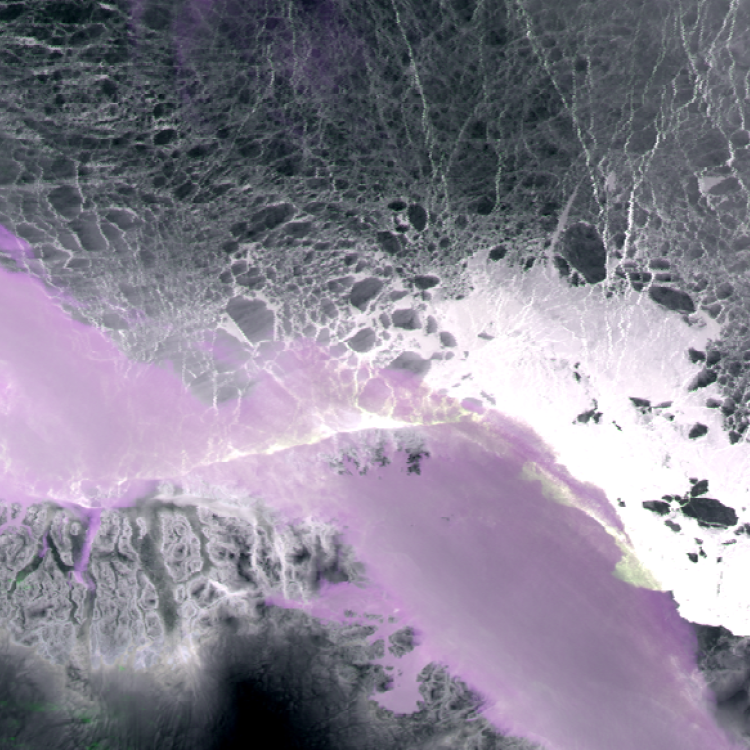06 May 2022
12 May 2021
By Gorm Dybkjaer and Eva Howe (DMI) and Anne O'Carroll (EUMETSAT)
Sea, ice and land surface temperatures are important for the exchange of energy between the surface and atmosphere and for sea ice, the sea-Ice Surface Temperature (IST) controls ice growth. IST is, therefore, a crucial parameter in sea ice modelling.
To estimate radiative fluxes within 5 W/m2, the surface temperature must be known to an accuracy of less than 1 K, and optimally without systematic error. 1 K is the target accuracy for the performance of the SLSTR IST product.
Several satellite IST products are based on Thermal InfraRed (TIR) data, all showing similar performance precision, typically within 2–4 K, depending on the validation context. With the SLSTR instrument, it was anticipated there would be a satellite retrieval with improved performance, relative to existing satellite IST products, due to the advanced design of the SLSTR radiometers and experience from the SLSTR predecessors, ATSR and AATSR.
Based on an IST algorithm review and subsequent performance tests, two IST algorithms were selected for the SLSTR prototype processor, a single-channel-dual-view (DV) and a split-window-single-view (SW) algorithm. The selected IST algorithms use TIR data from SLSTR channels S8 (Tb11) and S9 (Tb12) on a 1 km grid, in Nadir and Oblique views.
The algorithms are as follows:

where, ax are calibration coefficients, Tb’s are satellite brightness temperatures and the subscripts 11 and 12 represent the centre wavelength of the given satellite channels (in microns). Nadir and oblique represent the sensor view. θ is the satellite view angle.
The single most important element of a TIR-based satellite IST processor is cloud screening. For the SLSTR IST prototype processor a combined cloud screening methodology was chosen. The probabilistic SLSTR Sea ice cloud screening algorithm was applied during daytime (Liberti 2017, GEO-KCNR study 2017 Cloud screening over sea-ice and marginal ice zones - Final Report).
During night and twilight the native basic cloud mask provided in the SLSTR L1 product was applied. This composite method proved slightly, but consistently, better than an alternative probabilistic cloud mask from the University of Leicester (Product Validation and Evolution Report, Sea-ice surface temperature retrieval and validation for Copernicus Sentinel-3 Sea and Land Surface Temperature Radiometer).
Results are shown in Figure 1 where monthly mean performance values from September 2016 to March 2017 are plotted. The annual mean statistics for IST_SW are approximately, std: 1.4 K, 1.9 K and 2.6 K, for day, twilight and night time, and corresponding biases are -1.5 K, -1.1 K and -1.4 K. The annual mean statistics for IST_DV are approximately, std: 1.6 K, 2.3 K and 3.1 K, for day, twilight and night time, and corresponding biases are -1.9 K, -1.3 K and -1.8 K.
The current performance of the SLSTR IST products is consistent through time and across seasons over a one year period. The performance of IST_SW and IST_DV has proven comparable, or superior, to existing satellite IST products. Further improvements in SLSTR IST are expected through evolutions of the cloud-screening over sea-ice, in particular during twilight and night time.
The main focus of the SLSTR IST validation work so far, is performed against high quality surface temperature observations from automatic weather stations on the Greenland ice cap. A more thorough validation of the SLSTR IST performance over sea ice is recommended, but challenging due to limited availability of high quality sea ice observations. The lack of high quality sea ice in situ observations is highlighted as a critical link for improving sea IST algorithms and products in general.
Examples of level-3 IST data are shown in Figure 2, for six hours of SLSTR data on 18 May 2020.
EUMETSAT will use this prototype to deliver demonstrational IST products later in 2021, and then to develop an operational SLSTR IST processor. No clear dates are known yet as the schedule is still being confirmed.




